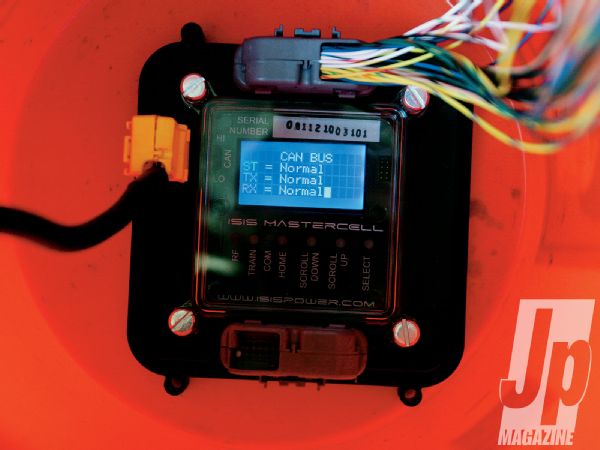
If you don't pay much attention to new cars (and who cares about a Coke can on wheels?) you might not know that the wiring we have all come to know in our older Jeep vehicles is gone. That's not to say it just disappeared one day, but vehicle wiring as you and I both know it is going the way of carburetors, gravity-fed fuel systems, and hit-and-miss engines (those things are cool!). The only thing that is ever going to be constant is change. Well, except for those new pennies that non-God-fearing people designed. Oh wait, I'm talking about different change.
 This is the brain of the system. All switches go to this mastercell and it then sends requests to the power cells downstream. The mastercell is programmable by computer or by face-mounted, push-button momentary switches. If that ain't enough, it is also waterproof to one meter. That means that you can sink your Jeep in water about up to your neck and this system will still work. Try that with a regular wiring harness.
This is the brain of the system. All switches go to this mastercell and it then sends requests to the power cells downstream. The mastercell is programmable by computer or by face-mounted, push-button momentary switches. If that ain't enough, it is also waterproof to one meter. That means that you can sink your Jeep in water about up to your neck and this system will still work. Try that with a regular wiring harness.
About 10 years ago, auto manufacturers put computers in control of not only the engine of the car, but also the entire body and chassis. It is called a Controller Area Network Bus, or CAN Bus system. At first I thought they did it just to make my life harder; now I needed to learn how to work a computer to fix what I was already fixing. After a while, though, someone told me that the CAN Bus was like a super highway and the way we were doing stuff was like a single-track dirt trail.
Picture if every car had a road that took them to only one place and no other car could use that road. So you'd have a road from your house to work, a separate road from your house to your girl's house, and a separate road back home. Now, apply that to every place you go... there would hardly be enough space for all the roads needed just for you, much less anyone else.
On the other hand, a CAN bus system is like an interstate, with many lanes carrying many more cars at much higher speeds than dirt roads can. Also, more than one car can be on the same road at a time, and can get off wherever they have to in order to get where they are going. There is a reason why we use interstates instead of dirt roads like we did in the first half of last century.
Auto manufacturers have known for years that by using multiplexing, or sending signals to many components on the same wire, they could shave 50 pounds out of just the wiring harness. And like OBD2 systems that control our engines, it is way easier to figure out the problem when something goes wrong.
Well, Littlefuse has figured out a cool way to completely retrofit your old Jeep to today's wiring standards. The system is called the ISIS intelligent multiplexing system and is easier to install, lighter, and more rugged than what you are running now. Here are some of the highlights of how this system really works and why it is a great match if you are looking at a complete wiring harness for your Jeep.
PhotosView Slideshow



